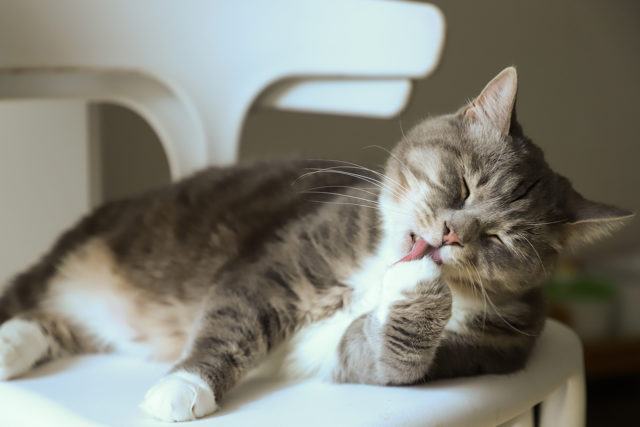Don’t Brush Off Feline Dandruff
Dandruff may be a cosmetic inconvenience that many people dread, but cats can suffer from this condition as well.
 Dr. Lori Teller, a clinical associate professor at the Texas A&M College of Veterinary Medicine & Biomedical Sciences, shares with pet owners the diverse causes of this condition and how to treat dandruff in a feline friend.
Dr. Lori Teller, a clinical associate professor at the Texas A&M College of Veterinary Medicine & Biomedical Sciences, shares with pet owners the diverse causes of this condition and how to treat dandruff in a feline friend.
“The causes of dandruff in cats can range from relatively simple—such as obesity that limits a cat’s ability to groom, allergies, or the build-up of the undercoat—to more serious issues—such as fleas or a skin infection—to very serious issues—such as cancers like cutaneous lymphoma,” Teller said. “There is also a condition called ‘walking dandruff’ that is caused by the Cheyletiella mite. This mite is usually prevented by flea control products.”
Other potential causes of feline dandruff include other external parasites (such as ticks and demodectic mange), bacterial or fungal infections, malnutrition, or an interrupted ability to groom (caused by factors like kidney disease, diabetes mellitus, pancreatitis, or even discomfort from arthritis).
“If an owner notices dandruff, it is certainly worth having the cat checked to rule out an underlying problem, especially if the cat has other concurrent problems,” Teller said. “If the cat is itchy; losing hair; vomiting; has a change in appetite, water consumption, or litter box use; or if the owner notices skin lesions or parasites, it is worth a visit to the veterinarian.”
Teller also advises that cat owners who are allergic to their pet may be bothered by cat dander and that a veterinary visit may allow for treatment of the cat that can help alleviate allergy symptoms in their owner.
“The treatment for feline dandruff will depend on the cause,” Teller said. “Some parasites may be treated with good flea control. Infections may require topical or systemic antibiotics or antifungals. Certainly, any underlying systemic disease should be treated. If obesity or arthritis is part of the problem, weight loss or pain control may be recommended.”
If no underlying problems are determined, an owner might be advised to brush their cat daily to distribute their pet’s natural skin oils throughout the coat and remove existing dandruff. If a cat has long hair or a thick coat, the cat may need to be brushed several times a day.
Cat owners should consult their veterinarian to determine which grooming practices are best for their pet.
“If the dandruff is more than just a few flakes, if the cat is itchy or is not acting normally, or if anyone else in the family (human or animal) develops skin lesions, it is worth a trip to the veterinarian,” Teller said.
Although it is important for pet owners to practice their due diligence and check in with their veterinarian to rule out the more serious causes of feline dandruff, Teller says that in many cases, dandruff is a minor condition.
“Most of the time, dandruff is a benign problem for the cat,” she said. “Fortunately, other cats don’t judge them for flaky skin, so if your veterinarian gives your cat a clean bill of health, don’t get too bothered by the dandruff.”
Pet Talk is a service of the College of Veterinary Medicine & Biomedical Sciences, Texas A&M University. Stories can be viewed on the web at vetmed.tamu.edu/news/pet-talk. Suggestions for future topics may be directed to editor@cvm.tamu.edu.


